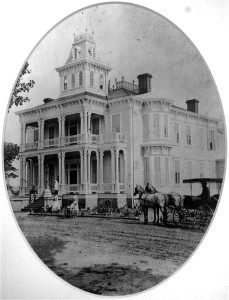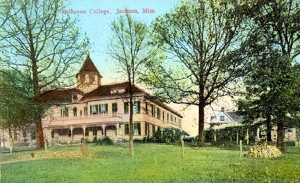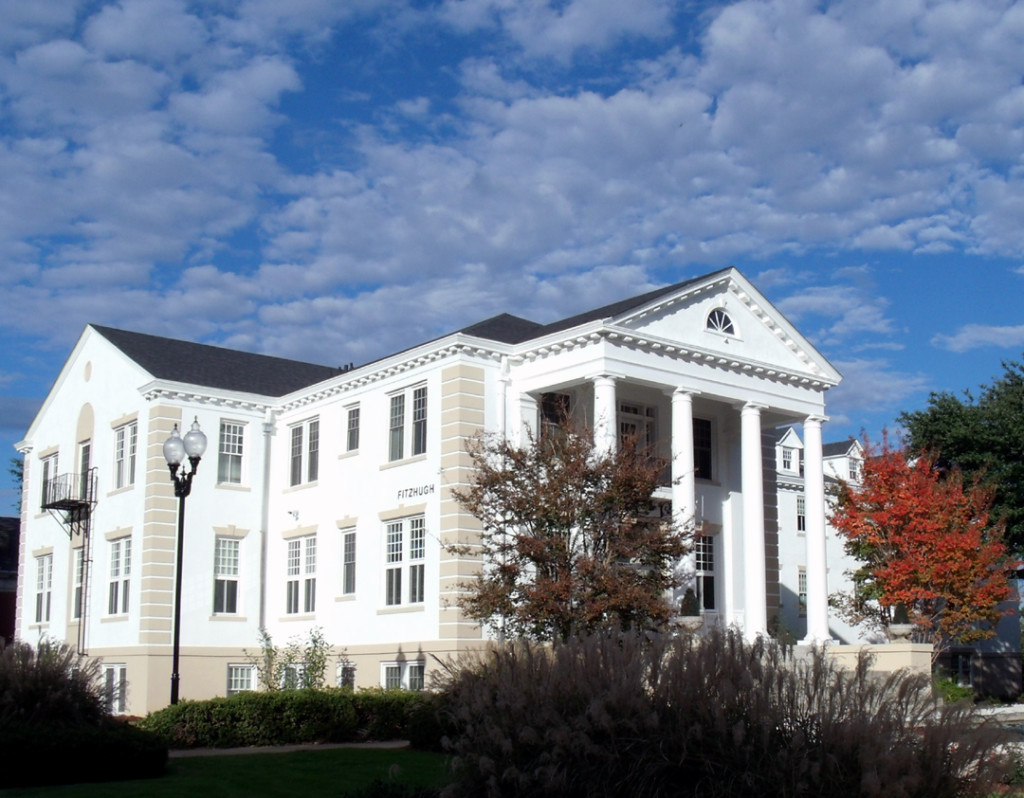Belhaven University has been around for a little over 120 years – longer than the neighborhood in which it resides and only five years removed from the beginning of neighboring Millsaps College. The college began as a girl’s school, progressed to co-educational sixty years later, burned three times, and merged with an institution that no longer exists. It provided pasture for cows in its early days and boasts campuses throughout the southeast today. But I may be getting ahead of myself. Let’s start at the beginning.
Who Was Dr. Fitzhugh?
Dr. Louis T. Fitzhugh (1841-1904) was the founder of the modern Belhaven College and served as its initial owner and first president. He came to Jackson in 1894, following a successful career as president of Whitworth College in Brookhaven. He had previously been a member of the faculty at the University of Mississippi. He launched Belhaven as a private school for girls and was influenced in his academic endeavors by Millsaps College and his association with the W.B. Murrah family. Fitzhugh’s new school was named for the old Belhaven mansion purchased from Colonel Jones Hamilton. 
Fire and Fate – Historical Twins
Three separate fires played a major role in the College’s early history. Belhaven was chartered as a private, one owner (Dr. Fitzhugh) institution in 1894. It was designed to be a four-year girl’s school. It was located in Dr. Hamilton’s deeded mansion on Boyd Street (now the 900 block of Bellevue), and was called Belhaven College for Young Ladies. This structure was totally destroyed in a massive fire on February 7, 1895 and replaced the following year with a single dwelling frame structure on the same site.
Mrs. J.R. Preston, wife of Belhaven’s second president, remembered in a mid-20th century address details of the first early campus. “As I recall the scenes of Belhaven as I first knew it, the white buildings with green blinds came before me, the two story dormitory and school building as one, with a porch adorned with attractive grill work, running along the front; the cupola rising above all, by its presence. I see beautiful, far-reaching views to be seen from all buildings for there was no northeast Jackson then. 
Dr. Preston (1853-1922) came to Belhaven from his presidency at Stanton College in Natchez. He was a former State superintendent of education and largely responsible for the public education system in place in Mississippi today. The State’s official motto Virtute et Armis (Valor and Arms) was coined by Preston and has appeared on the Mississippi coat of arms since 1894. A second devastating blaze began on October 19, 1910, from a furnace spark which landed in the dining room of the main building. According to Mrs. Kenneth Kraft and Mrs. Henry Mills, Dr. Preston’s daughters who witnessed the fire as children, the October day was dry and windy. The fire wagons came immediately, but the hydrant was at the foot of the hill. With no water pressure, nothing could be done. Preston decided for business and personal reasons not to rebuild Belhaven. He discussed his decision with his pastor J.B. Hutton of First Presbyterian Church in Jackson. As a result, the Presbytery received as a donation by Preston title and charter to the school which was renamed the Belhaven Collegiate and industrial Institute on July 25, 1911. The Boyd Street site was abandoned and construction began on a new academic building on the corner of Harper and Park Streets– later to be renamed Pinehurst and Peachtree. Belhaven Street, to reach from the center of the campus to North State, was a dotted line on the maps of the day, a dirt road and as they say “only a gleam in the eye.” Fate would intervene again in a number of ways 16 years later. (3), (4), (5)
How Did Fitzhugh and Preston Halls Get Their Names?
On August 9, 1927, lightning struck the main building and destroyed the major part of the plant and most of its contents. This was the building facing Peachtree Street which housed dormitories on the first and second floors, a kitchen and dining area on the north end and a chapel and gymnasium on the south. One can only imagine what went through the mind of President Guy T. Gillespie as he received a Western Union wire while on board a train to Princeton University to deliver a speech. It appeared at first that the building was a total loss. Yet from the ashes of that summer day rose the phoenix of the modern day Belhaven University. It reset the course of the school’s history. The board of trustees met the following day and began plans to rebuild. Meanwhile, Gillespie had plans of his own. While taking an architecture course at Columbia University, he was required to do a design project. He applied this experience to the task at hand. He never really liked the campus being all one building and so he developed a plan for taking out the burned center section creating two distinct buildings which are Fitzhugh and Preston Halls today. Between the buildings was built a concrete lagoon with columns on either side. The beautiful lighted fountain which can be seen from far down Belhaven Street stands in this location now. (3) (6) (7)
The Years of Famine
Dr. Guy Gillespie began his presidency in 1921 and remained as head of the college for 33 years. He faced nearly insurmountable challenges in areas of endowment, enrollment and accreditation during his tenure. It would be no stretch to say that while Fitzhugh and Preston fathered the institution, Gillespie saved it during its formative years. The battle for accreditation, the lifeblood of every serious educational institution, began in earnest at a May 21, 1929 meeting when Gillespie announced to his board that the Southern Association of Colleges and Schools had denied accreditation to the school. Their reasons were that endowment was $100,000 short of the required amount, the library needed 2,000 additional books, faculty salaries were far below the Association’s minimum and the faculty included only one Ph.D. The following 25 years were a testament to tenacity, endurance, courage and prayer. While church, local municipalities, out-of-state funding sources, local businesses and private individuals did their best to help the college meet its endowment needs and other accreditation criteria, there was a depression to contend with followed by a world war.
Through perseverance and God’s help on the morning of June 1, 1946, Gillespie was able to read the following statement to his board: “The outstanding event of the year was the admission of Belhaven College to membership in the Southern Association of Colleges and Secondary Schools at the annual meeting of the Association in Memphis on March 28, 1946, and with the full accreditation of the institution as a standard liberal arts college.” Academically, Belhaven was legitimate. Its future was secured. Other historical landmarks were the designation of Belhaven as a co-educational institution in 1954, transfer of the college by the Synod of Mississippi Presbyterian Church in the United States to the Belhaven College Board of Trustees in 1972, and renaming the college Belhaven University in 2009. (3)
A Historical Anomaly
While many consider the birth of Belhaven as 1894, when Fitzhugh purchased the Hamilton property and received a charter for the establishment of the school, others point to 1883 as the beginning. Technically, others are correct. We have discussed the college’s difficulties with achieving accreditation which hindered its growth and academic credibility. One means of addressing this deficiency was a merger with the Mississippi Synodical College in Holly Springs on April 14, 1939. Consolidation of the two colleges took place under the following terms:
(1) Mississippi Synodical College would not close (but eventually did), but continue as a part of Belhaven College.
(2) Consolidation would take place as of June 1, 1939, and the Belhaven College Board would assume functions of the Mississippi Synodical College Board of Trustees.
(3) Assets and liabilities of the Mississippi Synodical College would be taken over by Belhaven.
(4) The Christian aims of both colleges would be preserved.
(5) The endowment, assets, and other permanent funds of Mississippi Synodical College would be kept intact and used as nearly in accordance with the intention of the original donation as possible.
(6) After liquidation of the outstanding indebtedness of Mississippi Synodical College, the residue would be used in the construction of a building or in some way to perpetuate the name of the college on the campus of Belhaven.
(7) Records of the Mississippi Synodical College were to be preserved at Belhaven.
(8) Dr. Robert Franklin Cooper, president of Mississippi Synodical College, was named vice-president of Belhaven.
Mississippi Synodical College opened in 1883. This date was adopted by the Board of Trustees as the founding date of Belhaven as it represented the oldest founding date of all of the institutions (Belhaven had merged with the McComb Female Institute when it was reopened by the Central Mississippi Presbytery in 1911), which were eventually absorbed into the college. (3) (8)
Today’s Belhaven
Belhaven University has come a long way from Fitzhugh’s dream of a Christian girl’s school in 1894 and that hot, windy afternoon in 1910 when Preston’s daughters watched fire consume that dream a second time only leading to a third. The college has survived three fires, a depression economy, elusive accreditation, myriad ownership and four name changes.
Today’s Belhaven University is a private four-year liberal arts institution and sits on a main Jackson campus of 42 acres bounded by Peachtree Street, Pinehurst and Greymont Avenues and Belvoir Place. It is composed of 13 classroom, dormitory and administrative buildings, a lake, a bowl, a pavilion, a commons and a lighted fountain. An Alumni Center is located on the west side of Peachtree Street near Riverside Drive. Every four years the City of Jackson hosts the International Ballet Competition and Belhaven University provides lodging for a majority of its participants from throughout the world. According to the Department of Communications, there are a total of 3,500 students, 1,100 traditional, with 500 living on the main Jackson campus, with 300 adult students on the Lefleur Campus. Seventeen hundred adult studies and graduate students are enrolled on campuses in Memphis, Houston, Orlando, Chattanooga and Atlanta, plus participating in a growing online program.
There are 27 undergraduate studies programs on the Jackson campus and five graduate studies programs including degrees in business and public administration. The ASPIRE Program, located in a facility on I-55 north in Jackson, provides an encouraging educational environment where adult graduate students can complete their degree programs while maintaining their careers and personal lives. The school competes well in the NAIA’s Mid-South and Southern States Athletic Conferences and the Baseball Blazers are looking forward to a stellar season this spring. A total of 17 bachelor and 13 graduate programs are housed on ancillary campuses in cities mentioned above. Associate degree programs are available on these sites as well. There are also extensive online studies available to the modern student. Remember back in 1929, when the library was 2,000 books short, insufficient for accreditation? The Hood Library now has 115,000 volumes and 500 periodicals. The Jackson campus has a faculty in excess of 90 professors and instructors, 20 of whom are Ph.Ds. The school has an endowment just under $5 million. (10) (11)
What Can We Do?
What can we do as a neighborhood to support this institution we see in many ways as our own? We can reflect a moment and ask ourselves some questions.
Have you spent some time on the campus walking trails lately to see all the new construction? Have you spoken with students or faculty members or walked along the lake by the practice fields and noticed the ducks and an occasional fisherman on a Sunday morning?
Did a friend or relative attend Belhaven back in the day; are they students now or plan to be?
Did you sit with your mother as I did as a child in the 1940’s by the lagoon filled with goldfish between Fitzhugh and Preston Halls and listened to her tell you of her own college days at Belhaven in the 1920’s? (She and the goldfish are gone but the memories and a magnificent fountain remain.)
Have you or those you know of a later generation visited Bitsy Irby Visual Arts and Dance Center at Peachtree and Euclid Streets, the Entergy Pavilion down the hill from the Bailey Commons or the Belhaven College of the Arts with its magnificent ballet performances on the western rise of Riverside Drive for an evening of cultural enrichment?
Did you know Eudora Welty who lived across the street? Do friends have coffee in her Shoebird Café in the McCravey Triplett Student Center? Did they visit the bookstore?
Have you done reading or research at the Warren Hood Library or voted in its Barber Auditorium?
Have you sat on the white benches along the faculty walk in Gillespie Commons?
Do you know anyone who built a home in Belhaven in the 1950’s or 60’s on Belvoir and knew it was once the northern shore of Belhaven Lake?
Did you swim or canoe in the lake as a kid or today watch its fountains display theior beauty near the practice fields?
Did your gang play football or baseball as children the bowl on Peachtree or watch your own children play soccer there only last week?
Have you seen or listened to the school’s free gift of the beautiful Belhaven Christmas Tree singing each season by the lake?
Have you or one of your friends bought a home in the neighborhood and in some cases spent more on renovation than the purchase price just so you can live here? Do we as residents and friends fully understand who gave our neighborhood its name?
Do you feel a sense of pride when people ask you where you live and you can tell them “Belhaven”?
There is always something which can be done to preserve a heritage of faith, courage, achievement and vision. There are commitments to be made, memories to be acknowledged, friends and associates to influence and work to be done. Dr. Fitzhugh will take the time in his eternal classroom to open to us his own book of life and acknowledge our support so that perhaps his hall and college will remain with us another hundred years attesting to the excellence of Christian good will. We have in Belhaven University a treasure and cornerstone to one of America’s great neighborhoods. You do not even have to go to school to realize how fortunate we are.
Bill Harvey
February 2012
Sources
(1) Parrott, Roger, “Letter to Alumni and Friends of Belhaven” (December 2011)
(2) Gillespie, G.T., Dr. Louis T. Fitzhugh, Commencement Address (1954)
(3) Gordon, James F., Jr., “A History of Belhaven College 1894-1981”, Jackson, MS, Belhaven College (1983)
(4) Preston, Mrs. J.R., “Memories of Early Belhaven”, speech (undated)
(5) Belhaven College, Sanford Map Company, sheet 19 (1918)
(6) Waibel, Paul R., “Belhaven College,” Charleston, SC: Arcadia Publishing Co. (2000)
(7) Parrott, Roger, “Thinking About Higher Education” Belhaven Tartan: (Winter 2011)
(8) “Belhaven University”, Wikipedia Encyclopedia (January 2012)
(9) Parrott, Roger, quote from e-mail (1/13/12)
(10) Belhaven University Department of Communications
(11) Belhaven University website
Acknowledgements
Greater Belhaven Neighborhood Foundation Executive Director Virgi Lindsay for the idea
- Henry Mills, M.D., grandson of Dr. and Mrs. James Rhea Preston for his kind hospitality and for sharing personal documents as to the early history of Belhaven
- Bryant Butler, Director of Communications, Belhaven College, for invaluable information on Dr. Louis Fitzhugh, photograph reproduction of the Hamilton Mansion and current Belhaven data.
- Charles Guidine, Archivist, Belhaven College Reference and Periodical Library for photos and access to current archival files
- Nancy E. Harvey, my wife, who provided technical assistance in writing; proofing and encouragement
- The Belhaven neighborhood itself by making this project worthwhile and for the privilege of allowing me to enjoy my old age as one who grew up with its landmarks, its institutions and its people.

